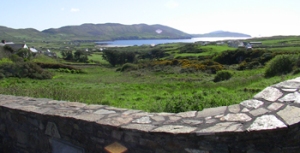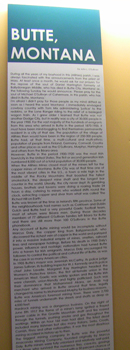
|
| Cafe Pasticcera Gamberini |
So to begin this new year with the sweetest of dreams, treat your eyes to this feast of Gamberini creations. Enjoy 2015!

|

|

|

|

|

|

|

|

|

|
| Cafe Pasticcera Gamberini |

|

|

|

|

|

|

|

|

|
| English Market Main Entrance |
Quoting from The English Market Website:
The unrivalled ability of Cork Harbour to shelter the biggest fleets assembled during the American War of Independence and later during the Napoleonic Wars was a major factor in the expansion of the provisions trade in Cork. The Cork Butter Market, with its strict and rigorously enforced system of quality control, was world famous and became the largest butter market in the world for its time.
| Cork Butter ~ Early Export Map |
| UCC Dairy Department Signage |
 |
| Veronica Steele |
Hi, Cynthia, It would be amazing to go to Butte, Montana to conduct a class. This area of Ireland has huge connections to Butte. It's spoken of as though it were the next village. If you ever get the resources together, I'll be over in a shot! Best wishes, Veronica
 |
| Allihies, Ireland |
 |
| Beara Ancestry Record |
 |
| North Star beckons to Allihies |
 |
| Entering Allihies |
 |
| Sullivan Family Headstone in Allihies |
 |
| Allihies Copper Mining Museum Displays |
In the mid-nineties a group of Allihies residents came together to discuss how they might preserve and present the local copper mining heritage of this unique area. The idea of Allihies Copper Mine Museum (ACMM) was born and hard work and dedication on the part of the local community brought it to fruition.
Attended by then-president Mary McAleese, the museum finally opened its doors in May, 2007.
 |
| Butte Story |
 |
| Skatepark in an abandoned Fiat Factory - Rome Italy 2004 |
Even camping had a premium price tag but the location was perfect. Free public shuttles took us directly from our tent spot to all the downtown Olympic venues. My only regret was not getting tickets to a wider array of events because it was all so easy to access.
Camping at the Winter Olympics demonstrated to my son that the unconventional can have unique rewards. Aside from a few TV production RVs the only other campers were all Canadian hockey fans! He left talking about attending the 2006 Olympics in Turin (even if we had to camp).There were no official skate parks in Rome at the time, so the recommendations took us into ordinary neighborhoods that most Americans would never visit. Through a common language of ollies, grinds and kickflips, Patrick connected with his Italian peers, who then included me as a respected elder accessory. We became honorary citizens of Rome.
After a few hours of riding on rough cobblestone streets, our young Roman friends invited us to a skating site in a gutted Fiat factory. The location wasn’t on any of my tourist maps so they drew some instructions in my notebook and said to meet them there in the evening.Of course, this could have been an unfortunate set-up but instead the outcome was even better than I imagined. While planning the trip, I'd read about notorious underground communities in Rome that hosted subversive art events. Being illegal and transient, they were virtually impossible for an outsider to find. Of course, I wanted to be there!
Arriving at the makeshift skate park made of plywood and scaffolding, Patrick was thrilled (in a teenage way) to be immersed in a gnarly scene half way around the world. While he was busy grinding and flipping, I explored the grounds outside and met a British expat my age who made sculptures from discarded car parts.Since he wasn’t feeling skateboard deprived, Patrick engaged with the attractions of ancient Rome. He loved the Pantheon and, for a teenager, was remarkably touched by Pompeii which was our only side trip. For both of us, though, the most enchanting experiences were the result of taking a risk.

|
| Fresh Laid Italian Eggs |

|
| Francesca Prepares Dough |

|
| Ancient but Accurate Scale |

|
| Basic Riccota Filled Tortelloni |

|
| Maestro Allessandro |

|
| Carla Instructs a Student from Texas |

|
| Filei Calabresi ~ Our First Pasta |

|
| Culinary Cathedral |

|
| Tortelloni in Process |

|
| Dried Spinach Tortelloni |
|
|
|
|
|
|
100 grams of "00" Flour per 50 grams of liquid. Liquid can be water, egg, broth, or a cooked vegetable such as spinach or mushroom. One shelled egg = 50 grams (Should be weighed if very large or small) 50 grams of cooked spinach = one egg. The following mixtures allow for additional 50 grams of flour during kneading. Plain Pasta 6 eggs and 550 g flour Spinach Pasta 6 eggs, 50 g cooked spinach, 650 g flour To Mix Gently blend flour into liquid. Knead until dough forms and stickiness is gone. Wrap kneaded dough in plastic. Let dough rest at least one hour before rolling. |
Filling Weight = Dough Weight 1.5 kilos Ricotta (cow) 200 grams grated Parmesan cheese 20 grams salt (to taste) 1 Egg Nutmeg to taste |
|
Place a dollop of filling into the center of each square. Fold dough corner to corner into a triangle over the filling. Squeeze the bottom tips of the triangle together to form a tortelloni shape. Practice often and eat your work! |
|